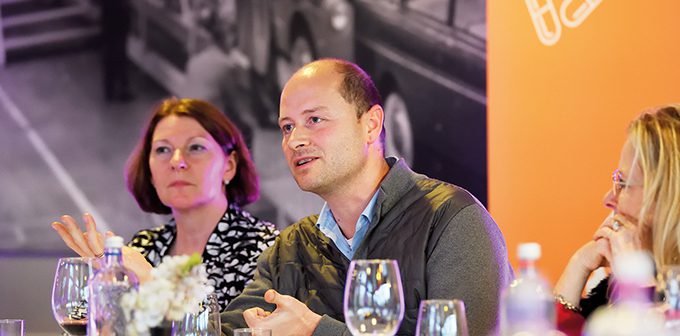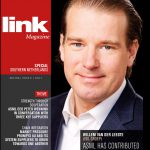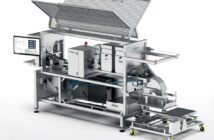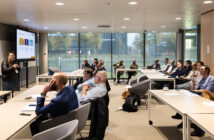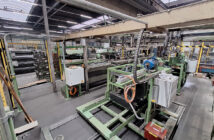Innovation, social and technological, is absolutely crucial in order to keep the healthcare system in the Netherlands, with its ageing population, at a high level and accessible to all. The sector is well aware of this, and a number of healthcare institutions are working on the issue. But real progress will require a major change of direction – within the sector, among health insurance companies and in government. A common platform, in which the care sector, the interest groups around it and med tech work closely together in order to make ‘1 plus 1 equal more than 2’: that would make a huge difference.
‘Healthcare meets Industry’ TalkING participants exchange insights and concerns.
This is the conclusion from the round table discussion on 19 March held in the former boiler house – now partly converted into a brasserie – on the site of GGzE, Eindhoven mental health services. The organisers, ING and Link Magazine, have brought together thirteen parties for this ‘Healthcare meets Industry’ TalkING session. They animatedly shared insights and also concerns. Paul Mencke (a partner at Govers Accountants) was the moderator, with Stanley Alards (Healthcare director for ING Large Business) as his sidekick.
Immensely challenging
What can I do, what do I want and what can we do for each other to tackle the not insignificant challenges facing the cure & care sector: offering high(er) quality care that is accessible to everyone, while the demand for care increases and a shortage of health care providers occurs.
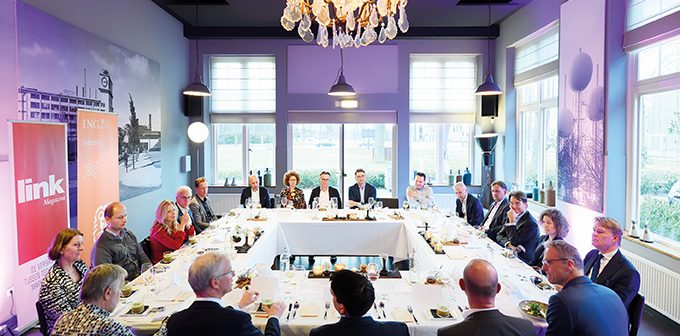
Clockwise, starting on the left: Chris Doomernik (director Health Valley), Valer Pop (CEO Life Sense), Marie Louise Vossen (director GGzE), Bert Tournois (CEO TDI), Willem Schellekens (Papayagogo, ING innovation), Chris Borgers (CFO Hittech Group), Marion Blohmenröhr (director programme management at Synthon), Stanley Alards (director Healthcare ING Large Business), John van Ginkel (publisher Link Magazine), Gert Jan Braam (Industry sector banker, ING), Gerrit van der Beek (CEO AME), Niels de Bruin (owner/CEO CLB Integrated Solutions), Jeroen van de Pas (director Philadelphia), Janne Brok (director Sioux LIME), Renco Kraak (director Industry, ING South-East Region), Thomas Plochg (director NPHF, federation for health), John Bierings (CFO Koraal), Arjan Karens (general manager Philips VitalHealth), Paul Mencke (partner Govers Accountants, moderator) and Pim Campman (reporter). Photos: Bart van Overbeeke
All the participants wholeheartedly agreed that part of the solution lies in social innovation, such as improved working methods in order to be able to do more with less and reduce the workload. And technological innovation offers plenty of opportunities for improvement. Robotisation, artificial intelligence (AI), Internet of Things, big data – all were discussed. Even if, according to Gerrit van der Beek (CEO of Eindhoven-based AME), it doesn’t all have to be terribly sophisticated. ‘You can get a long way by using technology that already exists.’
Too far
But: driving innovation in the care sector is very difficult. In the discussion about the first proposition put forward by Mencke, the central question is: how do you handle patient data, not least in the light of new AVG-legislation that makes citizens the owners of their data? GgzE director Marie Louise Vossen sees undesirable effects: ‘The board of the GGZ Benchmark Foundation (which uses patient data to compare the quality of care institutions, ed.) is calling it a day, because some one has figured out that there may be a privacy problem. Everyone is getting the jitters: “Oh God, imagine if someone takes a care institution to court.” The consequence is that we can pretty much throw away most of the data collected over the last five years. This has really gone too far.’
In her view, data and data analysis are essential for the ability to innovate in smart ways, informed by patient needs. ‘We are not going to solve increased healthcare consumption and care costs and the shortage of people by keeping everything as it was. Let’s have the guts to be a bit less conventional sometimes.’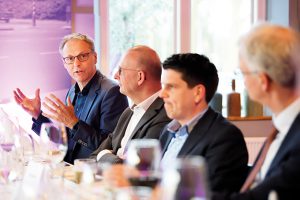
A huge mountain of data
Jeroen van de Pas, a director of Philadelphia Zorg, agrees: ‘When I started at Philadelphia three and a half years ago, everyone was talking about AI and big data. I’m not saying nothing happened, but in healthcare data is primarily used for management purposes. In terms of data analysis, we are still in the stone age. Yet we are sitting on a huge mountain of data, which could enable us to make much bigger improvements.’ One reason for this inertia, he and others say, is that government and health insurance companies are not providing ‘a single euro’ for innovation. ‘We think this is so important that we should be reserving a substantial part of the money for our normal activities to fund it. Despite the significant resistance to the idea, we continue to advocate that.’ Thomas Plochg, director of the NPHF healthcare Federation, also sees data as an enormous driver of improvement. ‘Although discussions about this issue are often reduced to privacy aspects. Privacy as an excuse not to change.’
Commercial market
Plochg raises another point: ‘Those huge corporations that are leading the way in data mining and analysis are also eyeing up the care industry. Imagine companies like Facebook, Apple and Amazon offering healthcare. It’s great that you can manage your health yourself, but a dominant commercial healthcare market has its own risks. Before you know it, we could be facing an elitist market, from which the lowest socio-economic class, the very people who can benefit from care the most, are excluded. And secondly: the business model of a company like Facebook is to sell on data they acquire for free. As a federation, we are definitely concerned about that trend towards ‘Big Brother is watching health’.’
‘For healthcare institutions, the focus is care, for universities it is scientific research and publishing, and for business it is making money’
In terms of data ownership and privacy protection, a lot is going to change. Alards cites PSD2 legislation, Vossen the ‘personal health environment’, a digital tool that gives citizens access to their own health data and enables them to collect, manage and share it.
Lifeblood
‘Data is our lifeblood. Without data, we would not exist’, says CEO Valer Pop. The med tech company markets a wireless non-invasive method that quickly cures women of urine loss, something that is common after a pregnancy, for example. ‘We do that by measuring when urine loss occurs and which pelvic floor muscle is most damaged. Based on that data – and on parameters like age, weight and activity during urine loss – we suggest a training programme that accelerates the healing process, and we also monitor that.’
A smart data solution, underwear with sensors and a training programme are what Life Sense’s success is based on. ‘When we started out in July 2015, the healing process took sixteen weeks on average, with a success rate of 60 percent. Our method has improved that to six to eight weeks and 85 percent.’ And what about privacy? ‘We don’t sell data, we don’t ask for names and addresses – but we do ask for permission. And we get it, because who wouldn’t want to contribute to rapid healing in tens of thousands of women all over the world?’
Significant healthcare cuts
The software company VitalHealth – known as Philips VitalHealth since its takeover in late 2017 – supports healthcare networks engaging in multidisciplinary collaboration in the primary and secondary healthcare chains in some 30 regions of the Netherlands. General manager Arjan Karens: ‘We do that by better coordinating collaboration around clients, measuring the results and actively involving citizens and patients in their care processes. In doing so, we offer clients a single good, secure care access point. An example of a healthcare network is the Oss-Uden-Veghel region. A few years ago, VitalHealth set up an open platform there linking together all 140 GP information systems in a network based around chronic care programmes. The GPs work closely with Bernhoven hospital in this region with 300,000 inhabitants. Thanks to the cooperation in the care network, the hospital has achieved a reduction of 16 percent in production, despite patient growth of 6 percent. Moreover, patient satisfaction has increased.’
From aftercare to pre-care
When it comes to data-sharing, many care professionals are still hesitant, agrees Karens. ‘We need to make sure they understand the added value of data-sharing. Take chronic patients such as diabetics; they need a lot of attention from GPs. The protocol is to visit the GP four times a year. But what do we see? A lot of patients in the ‘safe zone’ visit their practices far more often than that. With our self-care solution, this category of patients can keep track of their own blood sugar levels at home, massively reducing the burden on GPs. In Alphen aan den Rijn, the number of visits for patients with a cardiovascular risk went down from four to one per year. So yes, data-sharing can help organise medical practice more efficiently.’
To which Plochg responds: ‘What links my seventy federation members together is that we want to move from aftercare to pre-care. Our healthcare system is fantastic at dealing with acute and chronic problems. That success is also a danger; clinging to it could well bankrupt our healthcare system. What we need to move towards is prevention, a healthy lifestyle.’ Later he adds: ‘Allow me to be provocative for a moment: let’s look at diabetes from the opposite perspective – it’s simply lifestyle medicine. GPs would be better off sending 75 percent of their patients to the greengrocer’s rather than the pharmacy.’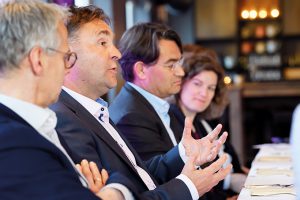
A bridge too far
What comes up again and again is the fact that there are many issues to be resolved when it comes to data collection and analysis. Chris Doomernik, director of Health Valley (a national network that brings together parties in the healthcare sector and inspires them to innovate more quickly), responds to an FD article that host Mencke has put on the table: residents of a new neighbourhood in Helmond are being offered the chance to reduce their housing costs by giving up data. ‘I think persuading people to share data, maybe without understanding the consequences, is unethical. For me that’s a bridge too far.’ Plochg responds: ‘That ship has sailed: the whole of social media is based on doing just that.’ And also: ‘Data storage can have a stigmatising effect and have a big impact on the rest of your life.’ Karens tries a different tack: ‘If, as a society, we want better and smarter care for our population, we will have to facilitate easier and secure sharing of medical data.’
‘I accept’ cookies
‘If a healthcare institution had to ask patients’ permission to use every item in their files, they would be swamped by the resulting administration. That is a huge threat to good care’, says Bert Tournois, CEO of TDI (a company that participates in promising high-tech firms in the agro-technology, food and medical sectors). Willem Schellekens (project manager at ING) raises the opt-in debates and all those ‘I accept’ cookies that pop up day in, day out. ‘If you were to read through all of them to find out what you are and are not accepting, it would take you months. It’s not realistic.’ Sidekick Alards downplays the issue: ‘Isn’t there a whole generation growing up who don’t care about all of that?’. Janne Brok, Director of Sioux LIME (the mathematics group of technology company Sioux): ‘I think it’s perfectly possible to draw up guidelines and conditions at the interface of data and ethics to deal with data in a good way.’
Fragmentation
We are already deep into the TalkING session when Paul Mencke puts forward a second proposition: ‘There is a lack of intensive cooperation between technology firms and the healthcare sector; that inhibits innovation in healthcare.’ Doomernik sees a shift from technology-push to taking the needs of patients and healthcare professionals as the starting point. ‘That is a positive development, not least because high-tech solutions are often not needed. What’s really important is that human touch. Beyond that, she sees a lot of fragmentation: ‘Although the walls between the sectors are still quite high, there is cooperation. But it is almost always between one hospital or healthcare institution and one or a few companies. It is far from being self-evident that other organisations will join in. That means initiatives remain small in scale and costs remain relatively high.’
Doctors’ stranglehold
‘Intensive discussions with institutions and patients/clients is the most effective way to come up with the best solutions’, says Niels de Bruin (owner/CEO of CLB Integrated Solutions, which supplies and maintains innovative care solutions such as alarm distribution systems). Tournois: ‘We have fallen flat on our faces a few times by developing new equipment only for doctors to turn around and say: ‘Yes, but that’s not how we do it’. They don’t want a better device, they want to hold on to their gold standard. That doctors’ stranglehold decides whether your technology is accepted or not.’ Karens disagrees: ‘There definitely are doctors who are well aware that they need to do things differently and better, and who actively provide input – and who can persuade their profession to follow them as thought leaders.’ Pop affirms: ‘If you want to market new technology, go to the teaching hospitals first. There you will find doctors who want to be ahead in their field and who will be interested.’
Time-bomb
According to Vossen, the main driver for organising healthcare fundamentally differently is the fact that the human resources. ‘The shortage of staff is a time-bomb; right now we are only seeing the tip of the iceberg. We really are going to be up against it in the care sector. It will force us to embrace technological innovations. They don’t have to be new innovations, because so many incredible smart new things have already been developed. The problem lies much more in implementation and scaling up in healthcare.’
Alards notes that 99 out of 100 care customers don’t have an innovation budget. ‘As a banker, I say: come up with a business case, then if contributes to innovation we can finance it.’ Of course that means sitting down with your care administration office or health insurer: innovation isn’t just about adding new things, it is also about daring to downscale what is not profitable or can be replaced through innovation. That usually brings costs down’.
Common platform
Van der Beek: ‘For healthcare institutions, the focus is care, for universities it is scientific research and publishing, and for business it is making money. If you want me to do something for you and I can see there is no money in it, my answer is: “Sorry, but I’m not going to do it.” Because we at Brainport are so good at working together, we can offer end customers a strong value proposition and turn 1 plus 1 into more than 2. We also need to instigate that collaboration between the care sector and industry. It won’t be easy, but it would really be a step forwards if they could establish a common platform.’ Brok: ‘Bringing together ideas from the care domain with what is technologically feasible; I believe that interaction is not yet properly organised in the healthcare sector. There is much to be gained in that regard.’
‘Smart nappy’
In the view of Chris Borgers, CFO of the Hittech Group (a system supplier of high-tech products with ten companies in Europe, Asia and the US), the healthcare sector would be wise to focus on social innovation. ‘With regard to technological innovation, the care sector needs to establish the right connections with the high-tech world, with its OEMS, many start-ups and private equity capital. It should then be possible to tackle the challenges we face, so that the Netherlands remains – however critical we sometimes are of our healthcare system – a top 10 country in healthcare.’
Blomenrohr (director programme management of the Nijmegen pharmaceutical company Synthon) stresses: ‘Break down prejudices, put yourself in the other person’s shoes and see what concrete steps you can take.’ ‘That’s a really good point’, chips in Van de Pas. ‘Among the technology firms, I get a sense that ‘innovation belongs to us’. But there are also a lot of good things happening in the care sector that entrepreneurs can learn from. Like the ‘smart nappy’, which we developed in co-creation with a data expert and a nappy manufacturer. It puts an end to the routine of changing nappies at regular intervals during the night; allowing many a client to enjoy some badly-needed sleep.’
In conclusion, Paul Mencke declares, ‘A great evening, animated conversations and, who knows, the calls to forge connections may lead to something beautiful.’ One participant sums it up like this: ‘I’m very enthusiastic. I could start something with anyone here at the table.’

